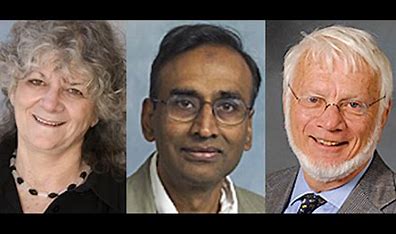Books of Interest
Website: chetyarbrough.blog
“Gene Machine“
Author: Venki Ramakrishnan
Narrated By: Matthew Waterson

Venki Ramakrishnan (Author, British-American structural biologist, shared 2009 Nobel Prize in Chemistry with Thomas A Steitz and Ada Yonath.)
“Gene Machine” tells reader/listeners of the discovery of the structure of ribosomes. Ribosomes are elemental cellular organisms (organelles) made up of proteins within living cells. They are genetic factories that process protein within the body. Without ribosomes, life as we know it, would not exist. Ribosomes repair cellular damage, maintain cell structure, and direct chemical processes within the body.

In the 20th century, after years of research, Ada Yonath, Venki Ramakrishnan, and Thomas Steitz discover clues to the structure of Ribosomes. Ramakrishnan story is about the complex process of scientific discovery. He reveals how scientists are motivated by the same desires of all humanity; namely money, power, and/or prestige. This is “the way” of the world, whether its religion, science, or society.
To the lay reader/listener, Ramakrishnan’s story is most interesting because it illustrates science research is more than a quest for knowledge. Curiosity and thrill of discovery are important, but it is the reward of being first and the accompanying money, power, and prestige that are scientists’ greatest reward.

Ramakrishnan somewhat ambivalently acknowledges Ada Yonath is the first scientist to recognize the critical role of ribosomes in genetic engineering. Ms. Yonath pioneers the use of crystallization in studying the elusive ribosome existence. However, Yonath fails to reveal a clear picture of the ribosome because of repeating the same chemical means of freezing the image of the elusive organelle. Ramakrishnan and his team of graduate students manage to come up with a chemistry formula that clears the image enough to make the structure of ribosomes more accurate.

Thomas Steitz helped perfect x-ray crystallography to more clearly map the structure of ribosomes.
Steitz’ work justified his inclusion in the Nobel award. The significance of Ramakrishnan’s story to a non-scientist is his unabashed and self-effacing humility when explaining his role in discovering the structure and purpose of ribosomes.
One wonders if Ramakrishnan harbors an opinion that Yonath’s pioneering of ribosome research is overblown.

Ramakrishnan criticizes Ada Yonath for being too verbose when participating in public conferences by recalling a conference that limited presenters to 15 minutes. Ramakrishnan explains Yonath went on for over 30 minutes despite the audiences expressed discontent. In the end, he acknowledges Yonath’s role in being among the first to suggest ribosome research was important. She was the first to use crystallography to identify its structure. Ramakrishnan notes those two facts justify her Nobel’ selection.

Ramakrishnan suggests winning a Nobel opens doors to opportunities that are unjustified in ways that have little to do with the specific work or a particular discovery.
Ramakrishnan explains much of the public think a winner of a Nobel could talk about any scientific subject with expertise. He notes the Nobel Prize is a great honor but is proffered to scientists that have achieved a finite discovery in a specific discipline, not a general understanding of all science. He goes on to explain how his country of birth (India), the country of England, and one suspects America, wish to claim him as representative of their countries–when, in fact, he is an individual who achieved success by dint of hard work, the help of others, and personal discipline. Ramakrishnan’s story explains how he pursued understanding of crystallography because it could help him achieve a goal. His point seems that the hard work of many scientists, not nationality or Nobel recognition, are keys to successful science research.
Ramakrishnan story is about science as an unending pursuit of knowledge that is refined and advanced by new techniques of examination.

In today’s science research, chemistry of crystallography is made less valuable with the invention of the atom-level microscope that offers direct, firsthand observations of the structure of human organelles like the ribosome. Ramakrishnan suggests science is an eternal search for knowledge.


One thought on “UNENDING PURSUIT”